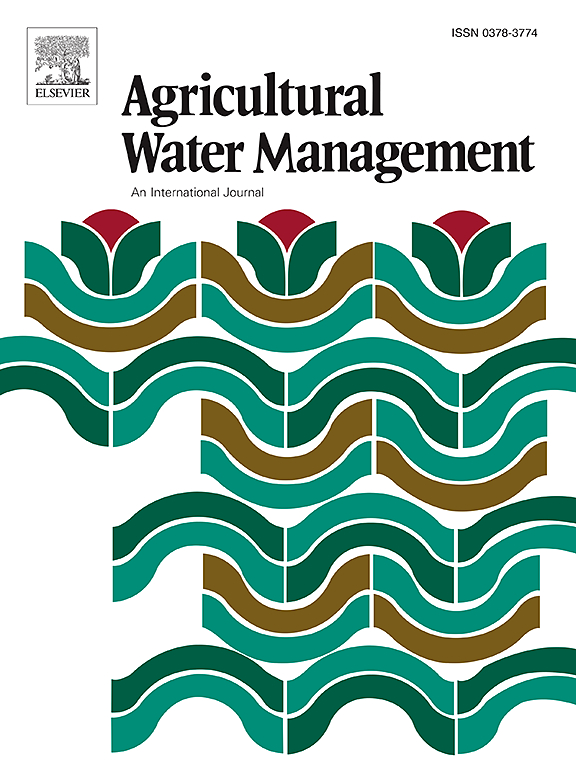Intermittent sprinkler irrigation during the establishment of strawberry (Fragaria ×ananassa Duch.) bare-root transplants conserves water without loss of yield and fruit quality
IF 6.5
1区 农林科学
Q1 AGRONOMY
引用次数: 0
Abstract
Commercial strawberry (Fragaria ×ananassa Duch.) production in Florida relies heavily on bare-root transplants, which typically have 3–5 leaves with partially desiccated roots. Successful establishment requires sprinkler irrigation during daylight hours for the first 10–14 days, leading to substantial water consumption. To address this issue, we evaluated the efficacy of intermittent sprinkler irrigation as a water conservation strategy. We conducted field experiments over two growing seasons [Season 1 (2021–22) and Season 2 (2022–23)] in west-central Florida using three major strawberry cultivars, ‘Florida127’, ‘Florida Brilliance’, and ‘FL 16.30–128’. Plants were subjected to four different intermittent irrigation programs during establishment: 10/0 (continuous irrigation), 10/10, 10/15, and 10/20 min (on/off) from 0800 to 1800 HR for 12 days after transplanting. The impact of intermittent irrigation on marketable yield was cultivar- and season-dependent. 'Florida Brilliance' exhibited a 27 % yield increase in Season 1 but no significant difference in Season 2. By contrast, the other two cultivars exhibited no significant yield response in either season. In ‘Florida Brilliance’, marketable yield was strongly correlated with early canopy growth, suggesting that the yield increase was due partly to accelerated canopy establishment. This surprising result could be explained by the role of stress-induced leaf senescence in enhancing acclimation to adverse environmental conditions. It is speculated that increased heat stress from intermittent irrigation promotes senescence of initial leaves, facilitating nutrient translocation to the crown and subsequently accelerating the formation of new leaves and roots. Our results demonstrate that, without significant yield loss, intermittent sprinkler irrigation can reduce water use by 50–67 % during the establishment of strawberry bare-root transplants, accounting for 322–429 mm of water saving (3.2–4.3 million liters per hectare). Importantly, this water-conservation practice is easy to implement and does not negatively impact fruit quality.
在草莓(Fragaria ×ananassa Duch.)裸根移植过程中进行间歇性喷灌,在不损失产量和果实品质的情况下节约用水
佛罗里达州的商业草莓(Fragaria ×ananassa Duch.)生产主要依赖裸根移植,裸根移植的草莓通常只有 3-5 片叶子,根系部分干枯。要想成功移栽,在最初的 10-14 天内,需要在白天进行喷灌,从而导致大量耗水。为了解决这个问题,我们评估了间歇喷灌作为一种节水策略的效果。我们在佛罗里达州中西部进行了两个生长季(第 1 季(2021-22 年)和第 2 季(2022-23 年))的田间试验,使用了三个主要的草莓栽培品种 "Florida127"、"Florida Brilliance "和 "FL 16.30-128"。植物在生长期间接受了四种不同的间歇灌溉方案:10/0(连续灌溉)、10/10、10/15 和 10/20 分钟(开/关),从 0800 到 1800 HR,移栽后持续 12 天。间歇灌溉对上市产量的影响取决于栽培品种和季节。佛罗里达 Brilliance "在第 1 季增产 27%,但在第 2 季没有显著差异。相比之下,其他两个品种在任何一季都没有明显的产量反应。在'佛罗里达之光'中,可销售的产量与早期冠层生长密切相关,这表明产量的增加部分归因于冠层的加速形成。这一令人惊讶的结果可以用胁迫引起的叶片衰老在增强对不利环境条件的适应性方面所起的作用来解释。据推测,间歇灌溉造成的热应力增加会促进最初叶片的衰老,从而促进养分向树冠转移,随后加速新叶和新根的形成。我们的研究结果表明,在草莓裸根移植过程中,间歇喷灌可减少 50-67 % 的用水量,节水 322-429 毫米(每公顷 320-430 万升),但产量不会明显下降。重要的是,这种节水方法易于实施,而且不会对果实质量产生负面影响。
本文章由计算机程序翻译,如有差异,请以英文原文为准。
求助全文
约1分钟内获得全文
求助全文
来源期刊

Agricultural Water Management
农林科学-农艺学
CiteScore
12.10
自引率
14.90%
发文量
648
审稿时长
4.9 months
期刊介绍:
Agricultural Water Management publishes papers of international significance relating to the science, economics, and policy of agricultural water management. In all cases, manuscripts must address implications and provide insight regarding agricultural water management.
 求助内容:
求助内容: 应助结果提醒方式:
应助结果提醒方式:


